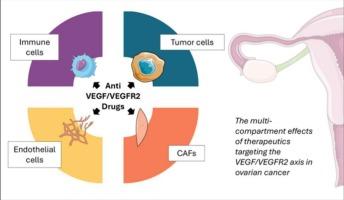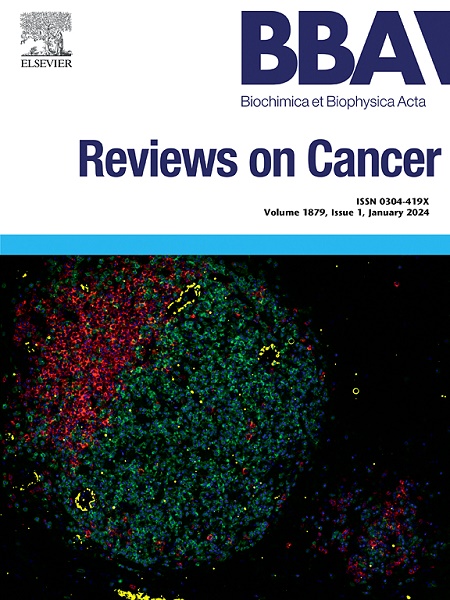卵巢癌中的VEGF/VEGFR2系统:从功能到药理意义
IF 9.7
1区 医学
Q1 BIOCHEMISTRY & MOLECULAR BIOLOGY
Biochimica et biophysica acta. Reviews on cancer
Pub Date : 2025-06-12
DOI:10.1016/j.bbcan.2025.189374
引用次数: 0
摘要
血管内皮生长因子受体2 (VEGFR2)是一种酪氨酸激酶受体,调节多种生物过程,包括胚胎发育、血管生成、组织稳态和癌症。VEGFR2被典型vegf和非典型配体激活,触发介导其生物活性的细胞内信号级联反应。临床前研究表明,VEGFR2在卵巢癌(OC)的进展中起着复杂而关键的作用,卵巢癌是一种致命的疾病,到2022年,全球有超过32万名女性患有这种疾病。已经开发了几种VEGF/VEGFR2轴抑制剂,目前已批准或纳入临床试验/临床前研究,用于治疗不同类型的OC。抗vegf /VEGFR2药物最初是作为抗血管生成药物开发的,现在众所周知,抗vegf /VEGFR2药物也会影响肿瘤细胞、免疫细胞和癌症相关成纤维细胞(CAFs),也会影响OC。在这篇综述中,我们讨论了VEGF/VEGFR2轴在OC细胞中的具体作用,并从这个角度讨论了VEGFR2靶向的治疗意义。解剖肿瘤细胞和基质细胞中由VEGF/VEGFR2系统调节的分子景观,将促进正在进行的针对卵巢癌治疗的翻译工作。意义声明:阻断VEGF/VEGFR2轴的抗血管生成药物被广泛用于治疗卵巢癌,尽管存在耐药和不良反应。最近的进展表明,抗vegf /VEGFR2药物作用于多个细胞室,包括卵巢癌细胞。本文讨论了VEGF/VEGFR2轴在卵巢癌细胞中的功能和药理意义,重点介绍了临床前和临床研究的见解。更深入地了解这一途径对于安全/有效地使用靶向VEGFR2途径的抗血管生成药物治疗卵巢癌至关重要。本文章由计算机程序翻译,如有差异,请以英文原文为准。

The VEGF/VEGFR2 system in ovarian cancer: From functional to pharmacological significance
The vascular endothelial growth factor receptor 2 (VEGFR2) is a tyrosine kinase receptor regulating a variety of biological processes, including embryonic development, angiogenesis, tissue homeostasis and cancer. VEGFR2 is activated by canonical VEGFs and non-canonical ligands, triggering intracellular signaling cascades that mediate its biological activity. Preclinical studies show that VEGFR2 plays a complex yet pivotal role in the progression of ovarian cancer (OC), a deadly disease with a global burden of more than 320,000 women in 2022. Several inhibitors of the VEGF/VEGFR2 axis have been developed and are currently approved or included in clinical trials/preclinical studies for the therapy of different subtypes of OC. Originally developed as anti-angiogenics, anti-VEGF/VEGFR2 drugs are now well-known to also affect tumor cells, immune cells and cancer-associated fibroblasts (CAFs), also in OC. In this review we address the specific role of the VEGF/VEGFR2 axis in OC cells, and, from this perspective, we discuss the therapeutic significance of VEGFR2 targeting. Dissection of the molecular landscape modulated by the VEGF/VEGFR2 system in tumor cells in addition to stromal ones will facilitate ongoing translational efforts directed toward OC therapy.
Significance statement
Anti-angiogenics blocking the VEGF/VEGFR2 axis are widely used to treat ovarian cancer, although resistance and poor response occur. Recent advances reveal that anti-VEGF/VEGFR2 drugs act on multiple compartments, including ovarian cancer cells. This review discusses the functional and pharmacological significance of the VEGF/VEGFR2 axis in ovarian cancer cells highlighting insights from preclinical and clinical studies. A deeper understanding of this pathway is essential for a safe/efficacious usage of anti-angiogenics targeting the VEGFR2 pathway in ovarian cancer.
求助全文
通过发布文献求助,成功后即可免费获取论文全文。
去求助
来源期刊

Biochimica et biophysica acta. Reviews on cancer
医学-生化与分子生物学
CiteScore
17.20
自引率
0.00%
发文量
138
审稿时长
33 days
期刊介绍:
Biochimica et Biophysica Acta (BBA) - Reviews on Cancer encompasses the entirety of cancer biology and biochemistry, emphasizing oncogenes and tumor suppressor genes, growth-related cell cycle control signaling, carcinogenesis mechanisms, cell transformation, immunologic control mechanisms, genetics of human (mammalian) cancer, control of cell proliferation, genetic and molecular control of organismic development, rational anti-tumor drug design. It publishes mini-reviews and full reviews.
 求助内容:
求助内容: 应助结果提醒方式:
应助结果提醒方式:


